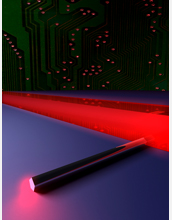Multimedia Gallery
Nanowire Laying Perpendicular to Polymer Waveguide
Depiction of a nanowire laying perpendicular to a polymer waveguide with one end inside the polymer.
Future optical data transmission modules will require the integration of more than 10,000 x 10,000 input and output channels to increase data transmission rates and capacity. This level of integration, which greatly exceeds that of a conventional diffraction-limited photonic integrated circuit, will require the use of waveguides with a mode confinement below the diffraction limit, and also the integration of these waveguides with diffraction-limited components.
To address this issue, a National Science Foundation (NSF)-funded research team, led by Antao Chen of the University of Washington, demonstrated the integration of multiple silver nanowire plasmonic waveguides with polymer optical waveguides for the nanoscale confinement and guiding of light on a chip. In their device, the nanowires lay perpendicular to the polymer waveguide with one end inside of the polymer. The group theoretically predicted and experimentally demonstrated coupling of light into multiple nanowires from the same waveguide, and also demonstrated control over the degree of coupling by changing the light polarization.
Results from this research could potentially lead to the invention of new types of optical switches that are very high speed and very small in size, and therefore have substantial, potential benefit to future high-speed telecommunication networks and the infrastructure of information technology. This achievement also produces valuable intellectual property that contributes to the technological leadership of the nation. [Research supported by NSF grant ECS 04-37920.] (Date of Image: December 2006)
Credit: Antao Chen and Yunan Xia, University of Washington
Images and other media in the National Science Foundation Multimedia Gallery are available for use in print and electronic material by NSF employees, members of the media, university staff, teachers and the general public. All media in the gallery are intended for personal, educational and nonprofit/non-commercial use only.
Images credited to the National Science Foundation, a federal agency, are in the public domain. The images were created by employees of the United States Government as part of their official duties or prepared by contractors as "works for hire" for NSF. You may freely use NSF-credited images and, at your discretion, credit NSF with a "Courtesy: National Science Foundation" notation.
Additional information about general usage can be found in Conditions.
Also Available:
Download the high-resolution JPG version of the image. (3 MB)
Use your mouse to right-click (Mac users may need to Ctrl-click) the link above and choose the option that will save the file or target to your computer.



